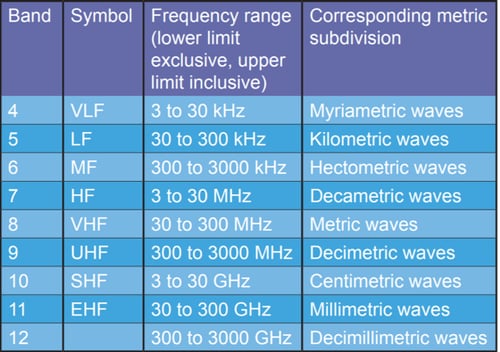The millimeter wave (mmWave) part of the electromagnetic spectrum is at the high end of the microwave region, which spans ~300 MHz to 300 GHz, and is usually taken to mean frequencies from ~30 GHz to 300 GHz and wavelengths in the range of 1mm to 1cm (Table 1). This dramatically increases available bandwidth, thus expanding achievable data rates, which makes these frequencies extremely interesting to teams around the world working on fifth generation (5G) communications.

Table 1. ITU Band Designations from the Provisional Final Acts Radiocommunication Conference 2015
Today, we see that mmWave frequencies are an integral part of the changes that 5G will bring about to communications over the next few years. At Knowles Precision Devices, we know filtering in 5G applications will be just as important at mmWave frequencies as it is below 3GHz, but with a new set of challenges brought about by the available filtering technology and the characteristics of mmWave systems. Let’s take a deeper look at some of the advantages and disadvantages of common mmWave filtering technology options for 5G applications.
Filtering Options
When we look at filtering for RF systems, an early choice comes from choosing between on-chip, integrated into the RFIC, and off-chip, filtering outside the RFIC with surface mount components or connectorized solutions. Challenges with implementing sufficiently high-performance filter structures on-chip arise from various factors including the physical characteristics of the semiconductor material and the cost of implementation. Thus, we prefer to focus on using off-chip options.
Below are brief overviews of seven off-chip filtering techniques for RF applications:
- Crystal Filters—Uses quartz crystal as the resonant element. The high quality factor (Q) of a quartz resonator makes for a steep band-pass. These filters are usually implemented at IF frequencies in the range of 10 MHz and Q factors fall in the range of 10,000 to 100,000.
- Acoustic Filters—Covers a range of frequencies up to 6 GHz and offers a good performance/cost tradeoff, making this the dominant off-chip filter approach in mobile devices today.
- Ceramic Filters—Covers a range of ~100 MHz to ~8 GHz. These filters offer similar performance to discrete lumped element inductor-capacitor (LC) designs but can be implemented in small form factor surface mount packages.
- Lumped Element—Provides a low-cost approach to implement a filter, but the attainable Q factors are limited. Discrete lumped element filters are usually used around the 30 MHz to 300 MHz range but can be built for applications up to 40 GHz. At mmWave frequencies, these filters are hard to implement because of the dimensional limitations imposed by the frequency since the filter elements must be much smaller than the wavelength of the transmission lines.
- Cavity Filters—A common approach in the 40 MHz to 960 MHz frequency range and can offer high selectivity under high power. These filters can achieve good performance but are physically large and usually only seen in infrastructure applications.
- Planar Filters—Manufactured using a thin-film process, and depending on the filter topology, can offer high Q and a reasonable approach to achieving performance in a small footprint when compared with discrete lumped element designs. Planar distributed element filters rely on carefully distributed transmission lines to create resonant structures and can be designed to tighter tolerances than a lumped element filter. Planar filters can be designed with temperature stable ceramics to provide frequency stable performance over temperature.
- Waveguide Filters—Characterized by high power handling capability and low loss given that the waveguide itself is a low loss medium, leading to their wide adoption in radar applications.
To better compare when to use these different techniques, Table 2 shows the optimal frequency ranges for each one. The choices in the mmWave range are limited to Cavity, Waveguide and Planar approaches.
Table 2. Common Filter Technology Frequency Ranges
Overall, 5G systems require filters with high percent bandwidth, good selectivity, and excellent temperature stability in a compact package, but do not necessarily require the highest power handling capability. Thus, we believe that Planar thin film filters emerge as a desirable approach from the standpoint of size, cost, and acceptable performance.
Download the RF Filtering for 5G Millimeter Wave Applications white paper to learn more about how you can use Knowles Precision Devices filter technology to enable your 5G applications.


